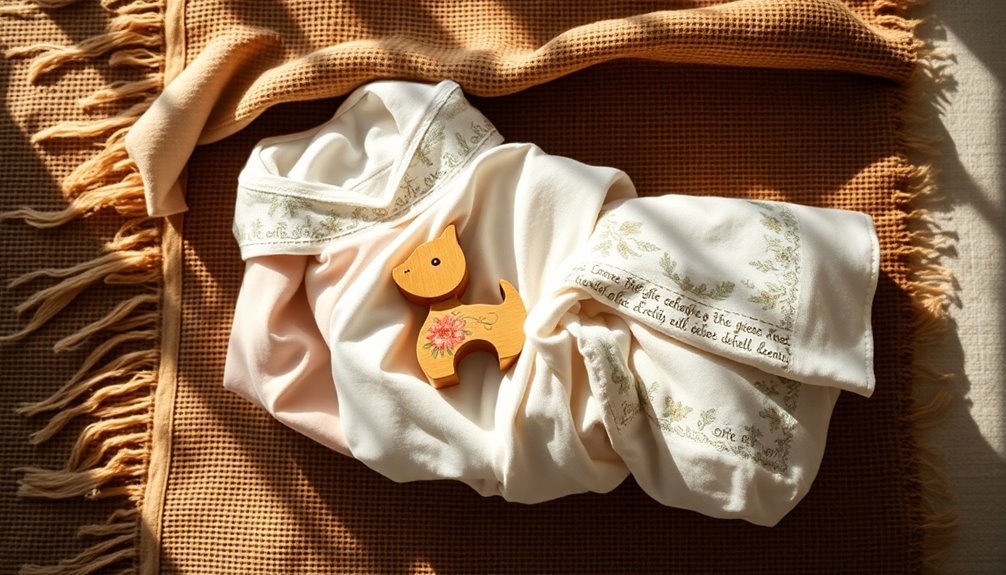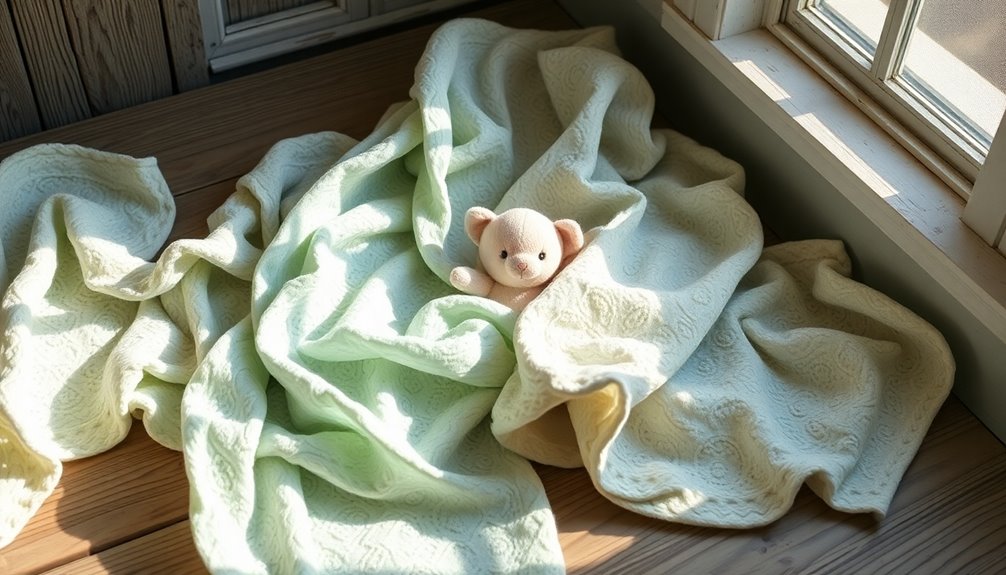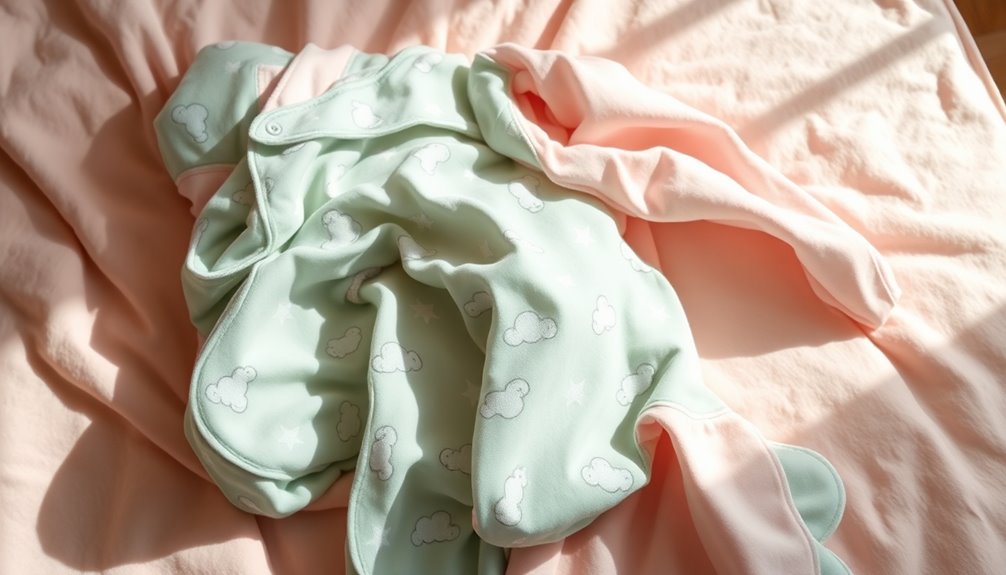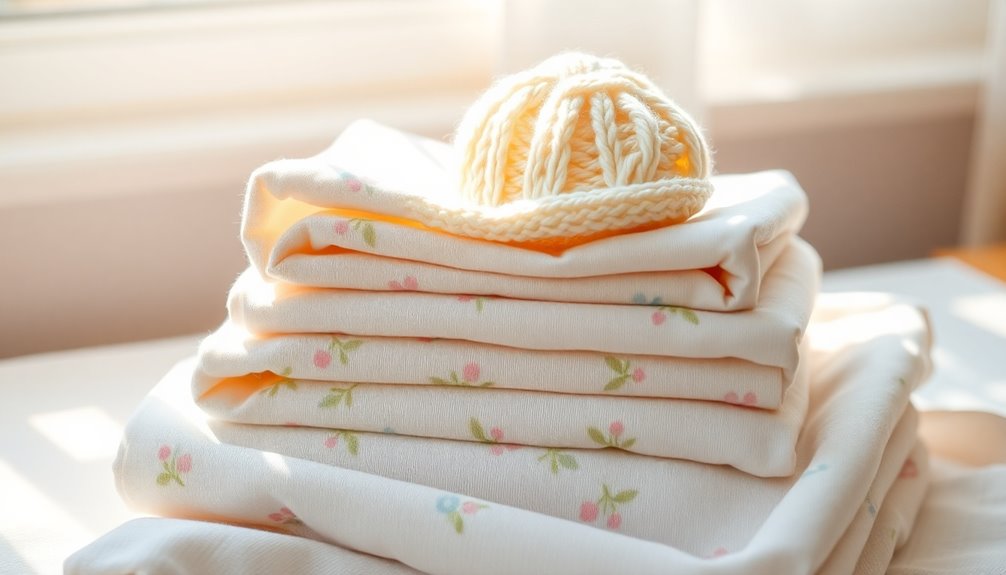Swaddling clothes are essential for comforting infants, helping them feel secure and sleep better. Historically, cultures embraced swaddling as a nurturing practice, with notable endorsements from ancient thinkers like Galen and Plutarch. These cloths, typically 4-5 inches wide and 5-6 yards long, wrap snugly around babies, mimicking the womb's environment. This practice not only reduces the startle reflex but also aids in safe sleep by minimizing the risk of SIDS. To ensure effectiveness and safety, it's vital to follow guidelines on snugness and materials. Discover more about the history and techniques of swaddling that can benefit your little one.
Key Takeaways
- Swaddling clothes originated in ancient cultures, designed to provide warmth and comfort while facilitating a smooth transition from womb to world.
- The Bible highlights swaddling as significant in Jesus' birth, symbolizing parental love and care, with implications of nurturing and sacrifice.
- Swaddling helps infants feel secure, reduces crying, and promotes longer sleep stretches, enhancing overall rest and comfort for both baby and caregivers.
- Safety guidelines for swaddling include using breathable materials, ensuring the swaddle is snug but not tight, and placing babies on their backs to sleep.
- Historical figures like Galen and Plutarch endorsed swaddling practices, emphasizing their importance in maternal care and infant development across cultures.
Introduction

In ancient times, swaddling clothes played a crucial role in infant care, reflecting a deep-seated cultural practice. You'll find that swaddling clothes, often made of narrow strips of cloth, were commonly used to wrap newborns, providing them with a sense of security and warmth as they transitioned from the womb to the outside world.
The Greek term for swaddling, σπαργανόω (sparganoō), emphasizes this nurturing aspect, showing how integral it was across various cultures. Historical accounts from figures like Galen and Plutarch highlight swaddling as a standard method of infant care, often accompanied by other practices like bathing and salting.
Beyond comfort, swaddling clothes served practical purposes, functioning as diapers and preventing infants from scratching themselves, which ultimately promoted better sleep.
This age-old practice isn't just about physical care; it also carries deeper meanings. Swaddling clothes symbolize love and protection, illustrating a family's commitment to nurturing their child.
Understanding these garments helps you appreciate the broader significance they held in both everyday life and theological contexts, where they represent compassion and care.
Biblical Significance of Swaddling

When you explore the biblical significance of swaddling, you'll find key references in Luke that highlight Jesus' humble beginnings.
These passages not only illustrate care and protection but also connect his birth to prophetic signs for the shepherds.
Understanding these references enriches your view of Jesus' life and the broader themes of nurturing and sacrifice in Christian faith.
Primary Bible References
Swaddling clothes aren't just a detail in the story of Jesus' birth; they carry deep biblical significance. In Luke 2:7 and 2:12, the mention of swaddling cloths highlights their importance. The Greek term for swaddling, σπαργανόω (sparganoō), describes the common practice of wrapping infants in soft cloths, a tradition rooted in ancient cultures.
These swaddling cloths serve as a sign for the shepherds, pointing to the newborn's identity as the Messiah and fulfilling prophetic expectations. The act of swaddling also symbolizes the nurturing care that Mary provided for Jesus, emphasizing the vital role of parental love and responsibility during early childhood.
This intimate gesture reflects the profound relationship between mother and child, illustrating how care begins even at birth. Moreover, swaddling holds rich theological implications. It can be viewed as a foreshadowing of Jesus' burial cloths, linking his humble beginnings in a manger to his sacrificial death on the cross.
Secondary Bible References
Several secondary Bible references enrich our understanding of swaddling's significance beyond the nativity story. In Ezekiel 16:4, swaddling metaphorically illustrates God's caring nature, emphasizing His nurturing love for Jerusalem. This connection highlights a protective theme that resonates throughout scripture.
Additionally, the Wisdom of Solomon (Wisdom 7:4) references swaddling to convey the commonality of human beginnings, emphasizing that even kings share the same humble start. This notion reminds you that greatness often emerges from simplicity.
The Greek term for swaddling, "sparganoo," signifies wrapping, which intriguingly links Jesus' humble birth to the burial cloths that enveloped Him after His death, as seen in the Gospel accounts. This connection deepens the impact of swaddling, painting a picture of life, death, and resurrection intertwined through divine compassion.
Ultimately, swaddling serves as a theological metaphor for God's mercy, fulfilling Old Testament prophecies regarding the Messiah's entrance into the world. By recognizing these secondary references, you gain a richer perspective on the profound significance of swaddling beyond the birth narrative.
Ancient Jewish Infant Care Practices

In ancient Jewish culture, the care of newborns was a detailed and thoughtful process, highlighting the importance placed on cleanliness and comfort. Newborns were typically washed and salted before being wrapped in swaddling clothes, ensuring they were clean and protected from the elements.
This swaddling process involved using narrow strips of cloth, usually measuring 4-5 inches wide by 5-6 yards long, securely wrapping the infant to prevent startling and promote a sense of security. This practice wasn't just a cultural norm; ancient physicians like Galen recommended it for its benefits in comfort and healthy growth.
You'd notice that swaddling clothes also served a practical purpose, doubling as diapers, showcasing the multifaceted approach to infant care in those times.
Moreover, the act of swaddling was seen as a vital part of maternal care, reflecting the nurturing responsibilities assigned to mothers within the family structure of ancient Jewish society.
Cultural Significance of Swaddling

Many cultures throughout history have recognized the importance of swaddling, seeing it as a vital practice that bridges the gap between the safety of the womb and the outside world. In ancient civilizations like Greece and Rome, swaddling symbolized the nurturing transition of infants. Greek literature often highlights its significance, with physicians such as Galen advocating swaddling for promoting comfort and security in newborns.
The typical dimensions of swaddling cloths, ranging from 4-5 inches wide and 5-6 yards long, allowed for effective wrapping that restricted movement while ensuring warmth. However, cultural perspectives on swaddling varied. For instance, while Spartans valued swaddling for its protective qualities, Scythians preferred allowing infants free movement to foster strength and independence.
Swaddling wasn't just about wrapping; it included washing and salting newborns beforehand, emphasizing hygiene and care in early child-rearing traditions. This multifaceted approach to swaddling reflects how deeply it resonates across different societies, showcasing the blend of practical and symbolic meanings attached to this age-old practice.
Ultimately, swaddling serves as a testament to the universal desire to provide safety and comfort to our youngest members.
Swaddling and Infant Comfort

When it comes to swaddling, you might've heard a few misconceptions that can lead to confusion.
It's essential to understand the safety concerns that come with this practice to ensure your baby's comfort.
Debunk Common Swaddling Misconceptions
Swaddling can be a comforting practice for your newborn, yet misconceptions often cloud its benefits. Many parents worry that swaddling restricts movement too much, but it's designed to provide a sense of security without tightly binding your baby.
Studies show that swaddling can help reduce crying and improve sleep patterns, making it a valuable tool for soothing your infant.
Another common myth is that swaddling leads to hip dysplasia. When done correctly, swaddling allows your baby's hips to move naturally. Remember, they should never be overly tight.
Swaddling remains beneficial for infants up to 3-4 months, especially for preventing the startle reflex that can disrupt sleep.
You might think swaddling is outdated, but it's actually a widely recommended practice supported by pediatricians due to its calming effects.
Just be cautious about materials: always choose breathable fabrics to prevent overheating, which is a known risk factor for Sudden Infant Death Syndrome (SIDS).
Safety Concerns With Swaddling
A safe swaddling practice can significantly enhance your infant's comfort and sleep quality. When done correctly, swaddling helps your baby feel secure and reduces their startle reflex, promoting longer sleep stretches.
However, it's crucial to pay attention to safety guidelines. Make sure the swaddle isn't too tight around the chest and hips; doing so can restrict breathing and impact healthy hip development. Pediatricians recommend that swaddled infants always sleep on their backs to minimize the risk of Sudden Infant Death Syndrome (SIDS).
Be mindful of when to stop swaddling. As soon as your baby shows signs of rolling over—typically between 2 to 4 months—it's time to discontinue the practice to avoid any safety hazards related to movement.
Additionally, consider using breathable, lightweight materials for swaddling. This helps regulate your infant's temperature and prevents overheating, which is an important safety concern.
Swaddling Techniques for New Parents

When you're new to parenting, mastering swaddling can feel overwhelming, but it's a skill that can greatly benefit both you and your baby.
By using the right techniques and materials, you can create a snug environment that promotes better sleep and comfort.
Let's explore some practical swaddling tips to support you on this journey.
Practical Swaddling Tips for Parents
Creating a cozy environment for your newborn can make all the difference in their comfort and sleep quality. When you swaddle your baby, use a lightweight, breathable fabric to prevent overheating, ensuring they're snugly wrapped without discomfort. Aim for a swaddling cloth that's about 4-5 inches wide and 5-6 yards long; this gives you enough material to wrap your infant securely without excess bulk.
Always place your baby on their back while wrapped in swaddling to lower the risk of Sudden Infant Death Syndrome (SIDS). It's also crucial to allow their hips to move freely for healthy development.
To swaddle effectively, lay the cloth in a diamond shape, fold down the top corner, and position your baby's head just above it. Wrap the sides gently but securely around their body.
As your baby approaches 2-4 months and begins to show signs of rolling over, gradually transition away from swaddling. This encourages independent movement and helps them feel more comfortable as they grow.
With these practical tips, you'll create a nurturing space that promotes better sleep for your little one.
Support for New Parents
Swaddling techniques can provide essential support for new parents navigating the early days with their newborn. When your baby is wrapped in swaddling, they feel secure, mimicking the womb's comforting environment. This snug feeling can help prevent the startle reflex, allowing for longer sleep durations and creating a calming atmosphere for both you and your little one.
As you explore swaddling, remember to choose a lightweight blanket or cloth that's about 4-5 inches wide by 5-6 yards long. Make sure the swaddle isn't too tight around your baby's chest, allowing some room for their hips to move freely to prevent hip dysplasia. This is crucial for healthy development.
You can use various methods to swaddle, from traditional rectangular blankets to modern products with Velcro or zipper closures for added convenience.
Just keep an eye on your baby; once they show signs of rolling over—usually around 2-4 months—it's time to stop swaddling for their safety. Embracing these techniques can help you adjust to parenthood while offering comfort to your newborn.
Swaddling's Historical Context Explored

The practice of wrapping newborns in strips of cloth, known as swaddling, has deep historical roots that span various cultures. Swaddling clothes were used to provide comfort and security, helping infants transition from the womb to the outside world. Historical texts reveal that notable figures like the physician Galen and philosopher Plutarch supported swaddling as essential for maternal care and infant well-being.
In ancient Greece, the term σπαργανόω (sparganoō) frequently appeared in literature, highlighting the importance of swaddling in childbirth and child-rearing. Different cultures had varying approaches to swaddling; for instance, the Spartans and Scythians favored allowing infants more freedom of movement, while Romans opted for a tighter swaddling method. These cultural preferences reflect diverse beliefs about infant care.
Typically, swaddling clothes measured between 4-5 inches wide and 5-6 yards long, designed to securely wrap infants. This practical approach not only calmed babies but also promoted better sleep.
Understanding the historical context of swaddling enriches your appreciation for this age-old practice, connecting you to generations of parents who sought to nurture their newborns with care.
Additional Resources

While exploring the rich history of swaddling, you'll find a wealth of resources that deepen your understanding of its significance. First, consider biblical texts, especially Luke 2:7 and 2:12, where swaddling clothes are mentioned in the context of Jesus' birth. This highlights not just their practical use, but their cultural and theological importance.
For a more historical perspective, look into writings by figures like Galen and Plutarch. They discuss swaddling as a nurturing practice across various ancient cultures, detailing how infants were bathed and salted before being wrapped in cloth for comfort and security.
Modern interpretations of swaddling also emphasize its benefits, such as improved sleep patterns and reduced risks of self-scratching and SIDS. To explore these modern views, resources like pediatric articles and parenting guides can be invaluable.
Additionally, reading "The Case for Christmas" by Lee Strobel can offer insights into the theological implications surrounding swaddling clothes.
Bible study tools from Logos Bible Software can further enhance your grasp of the historical context, making your journey into the world of swaddling both enriching and enlightening.
Frequently Asked Questions
What Are Swaddling Clothes in the Bible?
When you think about swaddling clothes in the Bible, you're looking at a symbol of care and protection for newborns.
These strips of cloth were commonly used to wrap infants, helping them feel secure during their transition to the outside world.
In the biblical narrative, they highlight the humble beginnings of Jesus and serve as a sign of his identity.
What Does It Mean by Swaddling Clothes?
When you hear the term "swaddling clothes," it typically refers to strips of fabric used to wrap infants.
This practice offers comfort and a sense of security, mimicking the snug environment of the womb. Swaddling helps your baby feel safe, promotes better sleep, and can even reduce the risk of self-scratching.
Essentially, it's a nurturing technique that emphasizes care and warmth in early childhood development, bridging the transition from womb to world.
What Happened to Jesus' Swaddling Clothes?
You might wonder what happened to Jesus' swaddling clothes after his birth. The Bible doesn't specify their fate, leaving it a mystery.
Some traditions suggest they were preserved as relics, symbolizing his humble beginnings. Others see a deeper connection, interpreting these clothes as foreshadowing his burial cloths.
Ultimately, while their physical existence remains speculative, they hold significant cultural and theological meaning in understanding Jesus' life and mission.
Why Is Swaddling No Longer Recommended?
Swaddling isn't recommended anymore because it can restrict your baby's hip movement, leading to potential joint issues like hip dysplasia.
Experts, including the American Academy of Pediatrics, caution against swaddling beyond the newborn stage due to increased risks of overheating and Sudden Infant Death Syndrome (SIDS).
Instead, you're encouraged to let your baby move freely, which helps them develop essential motor skills and the ability to self-soothe for better sleep.










